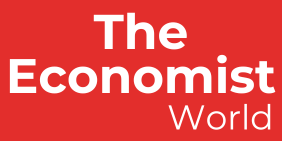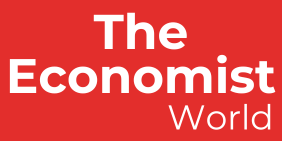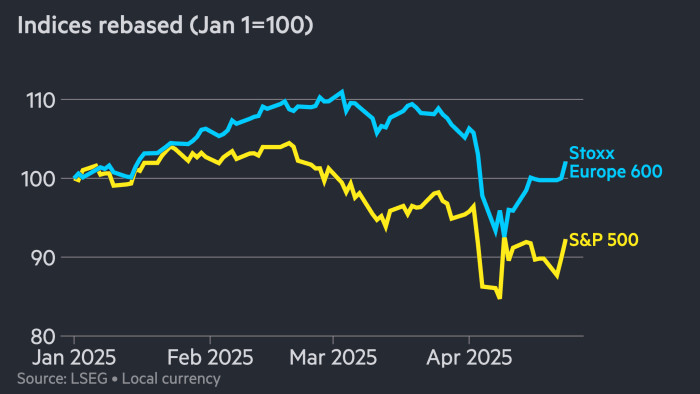Unlock the White House Watch newsletter for free
Your guide to what Trump’s second term means for Washington, business and the world
US stocks climbed after Donald Trump said he had no plans to fire Federal Reserve chair Jay Powell, easing worries about the independence of the country’s central bank that had rocked markets this week.
The S&P 500 ended Wednesday up 1.7 per cent, although the Wall Street benchmark retreated from earlier gains of more than 3 per cent in the latest volatile trading session. The tech-heavy Nasdaq Composite index climbed 2.5 per cent, while European equities also made gains.
The moves came after the president late on Tuesday reiterated his frequent complaint that the Fed needed to cut borrowing costs, but added: “I don’t want to talk about that because I have no intention of firing [Powell].”
“Markets will welcome his (begrudging) vote of confidence, but the damage to Fed independence has been done,” said Dario Perkins, of consultancy TS Lombard, in a note to clients. “Trump wants rate cuts, but his vicious attacks on Powell have made it harder for the central bank to deliver.”
Stocks had also been boosted by a potential easing of trade tensions with Beijing, after Trump also said on Tuesday that tariffs on Chinese goods would “come down substantially”.
However, Wall Street indices gave up some of their early gains later on Wednesday after Treasury secretary Scott Bessent told reporters that a de-escalation in the US-China trade war would have to be mutual.
“There would have to be a de-escalation by both sides,” he said, adding that the tariffs the two countries had imposed on each other amounted to an “embargo”.
“A break between the two countries on trade does not suit anybody’s interests,” Bessent said.
Charlie McElligott, an equity derivatives strategist at Nomura, said that “a massive chunk” of the earlier buying on Wednesday had been driven by hedge funds covering their short positions.
The US dollar rose 0.9 per cent against a basket of peers, although the currency continues to hover around multiyear lows having dropped more than 8 per cent this year so far.
Brent crude, the international oil benchmark, fell 1.9 per cent to $66.17 a barrel as traders weighed the possibility that Opec+ will accelerate production increases in June.
The broad Stoxx Europe 600 index rose 1.8 per cent on Wednesday, and Germany’s Dax index extended recent gains with a 3.1 per cent rise.
The 10-year US Treasury yield was slightly lower at 4.38 per cent. Bond yields move inversely to prices.
Wednesday’s moves come after a volatile month for financial markets following Trump’s “liberation day” tariff announcements, which triggered a multiday tumble for US equities. The S&P 500 remains more than 8 per cent lower so far this year despite rebounding this week.
Technology stocks have been hit even harder, with the Nasdaq Composite index shedding more than 13 per cent since the beginning of 2025.
Despite this week’s gains, investors remained wary. “There might be short-term relief because the tail risk of the US economy blowing up has been reduced, but is the level of uncertainty suddenly gone? No,” said Max Kettner, chief multi-asset strategist at HSBC.
Markets were rattled last week after Trump, who has been a persistent critic of Powell, signalled he believed he could dismiss the Fed chair before the end of his term in May 2026.
Bessent on Wednesday said that he did not have a position on whether Trump had the authority to fire the Fed chair. “I’m not a lawyer, I don’t have a stand on it,” the Treasury secretary said.
But Bessent said that Trump’s statement on Tuesday that he had no intention of firing Powell was consistent with the president’s comment last week that the central banker’s “termination” could not come “fast enough”.
“The word termination — terminus — can also mean the end, and ‘I can’t wait for his termination’ . . . He just could have meant May 2026”, Bessent said.
Salman Ahmed, global head of macro and strategic asset allocation at Fidelity International, described the confrontation between the White House and the Fed as “a manifestation of a fundamental tension” in the economy.
He said Trump’s tariff policies had “put pressure on the dual mandate of the Fed” by increasing inflationary pressures while also hurting growth.
“That tension is not going to go away fundamentally until we know where the tariffs are going to settle,” Ahmed said. “The day-to-day newsflow is going to lead to elevated volatility.”
Additional reporting by Ray Douglas in London and George Steer in New York



